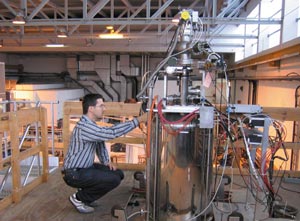
Image: Alban Kellerbauer
The atomic mass of a nucleus is important in a wide range of physics, as it conveys information on the nuclear binding energy. It is a unique property of each of the more than 3000 known nuclides. Now, experiments at ISOLTRAP at CERN’s ISOLDE facility have reached a level of precision where the mass measurements for extremely short-lived radionuclides are significant for fundamental studies that touch upon the very foundations of the Standard Model. Two recently published sets of measurements on neutron-deficient magnesium and rubidium nuclides concern the conserved-vector-current hypothesis of the weak interaction and the unitarity of the Cabibbo-Kobayashi-Maskawa (CKM) quark-mixing matrix.
According to the quantum-field theory of the electroweak interaction, the weak interaction has two components, a vector and an axial-vector part. In a manner analogous to electromagnetism, currents can be associated with each of these components, and the vector current is exactly conserved. This postulate is equivalent to the statement that the weak force is not influenced by the strong force and that the weak vector coupling constant is thus truly constant.
By careful choice of a particular weak decay whose initial and final states respect certain selection rules (so-called superallowed decays), the vector part of the interaction can be studied selectively. Within this subclass of decays, the nuclear matrix element depends only on the isospin, so a comparison of the Ft values (also called comparative half-lives) allows a direct comparison of the vector coupling constant.
An experimental value for the comparative half-life of a decay can be deduced from high-precision measurements of its atomic mass and its partial half-life
An experimental value for the comparative half-life of a decay can be deduced from high-precision measurements of its atomic mass and its partial half-life. In order to obtain truly comparable quantities, two small calculated corrections must also be taken into account. These describe radiative and spin flip effects, as well as a lack of overlap between the decaying nucleon and its daughter.
The mean of the Ft values of all decay pairs with the same isospin, together with the fundamental vector coupling constant from muon decay, can furthermore be used to calculate the first element Vud of the CKM matrix. Using this value, the most precise determination of Vud available today, the unitarity test of the quark mixing matrix currently fails by two standard deviations.
The ISOLTRAP experiment at ISOLDE is at the forefront of a new class of experiments that perform mass measurements on trapped exotic nuclides using the time-of-flight cyclotron resonance technique. For this purpose, a beam of radionuclides produced and mass-separated with ISOLDE is first accumulated and bunched. The ions are then mass-selectively cooled, before the mass of the radionuclides is measured via the cyclotron frequency in a precision Penning trap.
Now a team from Germany, France, the US and Canada has measured the masses of 74Rb and 74Kr as well as 22Mg and 22Na with unprecedented precision, ranging from 6 x 10-8 for the very short-lived 74Rb (T½=65 ms) to 1 x 10-8 for 22Na (T½=2.6 y) (Kellerbauer et al. 2004, Mukherjee et al. 2004). 74Rb is the shortest-lived radionuclide that has ever been studied in a Penning trap. The comparative half-lives obtained for the superallowed decays of 74Rb and 22Mg agree well with the previously known Ft values, thus confirming the CVC hypothesis in this new mass region and for isospin projection Tz=-1, respectively. However, improved calculations of one of the theoretical corrections (74Rb) and more precise measurements of the partial half-life (22Mg) are required before these data can have an impact on the test of CKM unitarity.
Further reading
A Kellerbauer et al. 2004 Phys. Rev. Lett. 93 072502.
M Mukherjee et al. 2004 Phys. Rev. Lett. 93 150801.








